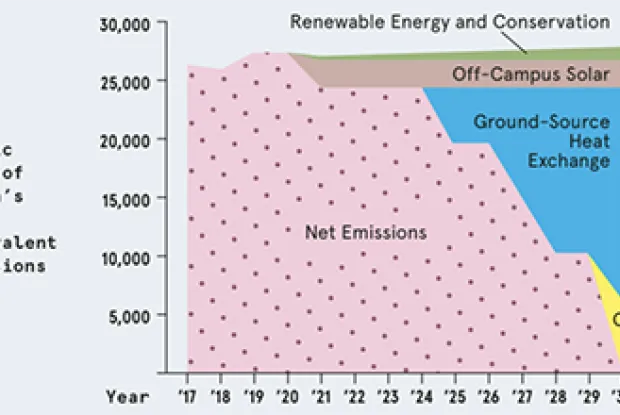Carbon Neutral by 2030
By decreasing its greenhouse gas emissions, reducing its energy consumption and cleaning up its energy supply with renewable sources such as solar and wind power, Smith is making good on its promise to achieve carbon neutrality by 2030.
Acting against climate change is a community-wide endeavor. Across campus, faculty, students and staff are investigating and testing innovative ideas around climate science, engineering, public health, policy and design—all in an effort to move the college—and the world—toward a clean, healthy and equitable energy future.
The Basics
Geothermal Energy
In summer 2022, Smith began work on an innovative geothermal campus energy project that will reduce the college’s carbon emissions by an eye-popping 80%, allowing the college to become carbon neutral by 2030.
“It’s the largest capital project in Smith’s history,” says David DeSwert, vice president for finance and administration. “It will represent somewhere between 35% and 40% of our capital expenditures over the next 10 years.”
Beyond that, the work fully aligns with the college’s mission and vision. “We knew it was important for Smith to take action on this because we believe that what we do in our campus operations reflects our values and what we’re teaching our students in the classroom,” DeSwert says.
The geothermal energy project may be the most concrete evidence of Smith’s commitment to sustainability, but it’s just one of many ways Smith uses its resources to live up to its stated values, DeSwert says. “We’ve also taken actions in our endowment to divest from investments in fossil-fuel-specific [asset] managers,” he says. “We believe in taking a comprehensive approach to practice what we preach.”

Our Commitments
Smith joined Second Nature (The Climate Leadership Network) by signing the Carbon Commitment. In doing so, the college pledged to create a climate action plan that included a “target date for achieving carbon neutrality as soon as possible.” Smith’s Sustainability and Climate Action Management Plan (SCAMP), released in 2010, outlined various strategies and technologies to investigate to achieve carbon neutrality by 2030.
In 2015, President Kathleen McCartney formed a Study Group on Climate Change (SGCC), made up of staff, faculty, trustees, alums and students, tasked with facilitating a campuswide examination of how Smith could most effectively respond to the challenge of global climate change. The study group’s work culminated in 2017 with a set of recommendations and priorities for academic offerings, campus programming and operations.
In December 2020, President McCartney underscored Smith’s persisting commitment by joining the “All In” movement on climate action signed by thousands of institutions, states and countries.

